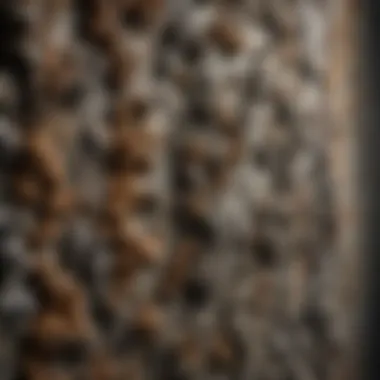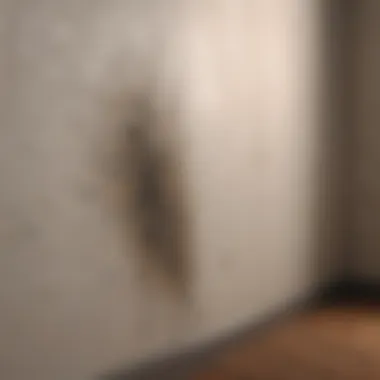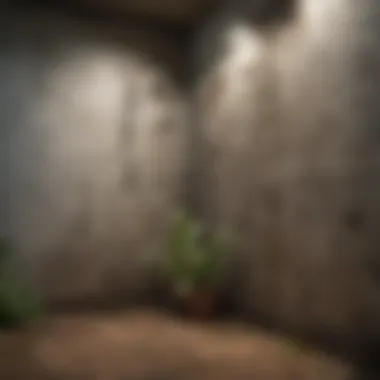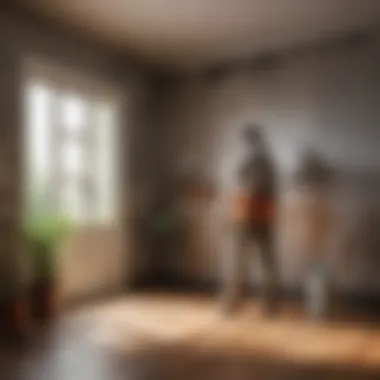Understanding Mold in Walls: Smells and Solutions


Intro
Mold in walls is not just an aesthetic concern. It stands as a significant risk to both structural integrity and occupant health. The distinctive odor associated with mold, often described as musty or damp, serves as a preliminary indicator of underlying issues. Recognizing the implications of this scent can help homeowners take effective action early on. This article will explore the origins of mold odors, their health implications, and practical solutions for detection and remediation.
The presence of mold can arise from various factors, such as water damage, humidity levels, and inadequate ventilation. In homes, mold can thrive in hidden corners, making it hard to detect until the smell becomes overpowering. Knowing how to identify and address these concerns is vital for maintaining a healthy living environment.
Throughout this piece, we will discuss the following:
- Origins and implications of mold odors
- Health risks related to exposure
- Effective detection and remediation strategies
- Practical tips for maintaining a mold-free home
By informing homeowners and design enthusiasts about these aspects, we aim to foster a deeper understanding of mold issues and promote healthier living spaces.
Intro to Mold in Walls
Mold is not just a visual nuisance; it poses serious risks to both health and home structure. Understanding the role of mold in walls is crucial for homeowners and enthusiasts alike. It allows for early detection, informed decision-making, and effective mitigation strategies. This section will provide an overview of mold, its types, and the specific concerns related to its presence within walls.
What is Mold?
Mold is a type of fungus that thrives in damp environments. It reproduces via spores, which are easily airborne and can settle on various surfaces, including walls. Mold needs moisture, organic material, and a suitable temperature to flourish. Often, it goes unnoticed until it becomes a larger problem. Its growth can lead to significant damage to property and pose health risks to inhabitants.
Common Types of Mold Found in Homes
Several types of mold can be commonly found in homes. Some of the most prevalent include:
- Aspergillus: This mold is often found in damp areas like bathrooms and kitchens. It can trigger allergic reactions in some individuals while being relatively harmless to others.
- Cladosporium: This kind can grow on fabric, wood, and other surfaces. It typically appears black or green.
- Stachybotrys chartarum: Often referred to as black mold, it can produce mycotoxins and thrives in materials with high cellulose content.
- Penicillium: This mold grows on materials that have been wet and can cause respiratory issues.
Recognizing the different types can help in both identification and potential treatment. By understanding the various forms, homeowners can take targeted action to remove mold and prevent its return.
Identifying the Smell of Mold
Identifying the smell of mold is a crucial step in protecting your home and health. Mold can thrive in walls and other hidden areas, often undetected until it becomes a serious issue. The smell is often the first clue, signaling potential problems before they escalate. Recognizing these odors early can help in taking action and mitigating health risks.
Characteristics of Mold Odors
Mold releases volatile organic compounds (VOCs) that create distinct odors. These smells can be musty or earthy, often compared to damp, rotting wood. Depending on the type of mold, the exact scent can differ. Common features of mold odors include:
- Dampness: The smell often resembles that of wet paper or fabric.
- Staleness: A stale or aged scent can indicate the presence of mold.
- Mildew-like: Mold may have a milder, less pungent odor than some other fungi, yet remains noticeable.
It is essential to note that not all mold emits strong odors. Early detection may require careful observation, especially if the mold growth is hidden.
How to Differentiate Mold Smell from Other Odors
Differentiating mold smell from other household odors can be challenging. However, some strategies can help. Here are notable points to consider:
- Location: Mold often appears in areas with high moisture, like basements or near plumbing. A lingering musty smell in these regions may suggest mold.
- Consistency: Mold odor is usually consistent and persistently noticeable. If you notice a similar smell in various parts of your home, it may be from a mold source.
- Contrast with Other Odors: Unlike kitchen odors or fresh paint, which can vary, mold smells tend to remain similar. If an odor lacks variability and has a damp trace, it could indicate mold.
- Environmental Triggers: Strongly consider seasonal changes. Increased humidity in warmer months can exacerbate mold growth, making the smell more pronounced.
"A distinct mold odor is often a precursor to health concerns and structural damage. Early action can prevent larger issues later."
Understanding the characteristics and context of mold odors is vital for any homeowner. Recognizing these signs early can lead to quicker response actions, ultimately promoting a healthier living environment.


Causes of Mold Growth in Walls
Understanding the causes of mold growth in walls is crucial for any homeowner or design enthusiast aiming to maintain a healthy living space. Mold does not merely represent an aesthetic issue; it poses significant health risks and can lead to structural damage if not addressed promptly. Recognizing the underlying factors contributing to its growth can effectively guide prevention strategies and remediation measures. By diving into moisture levels, poor ventilation, and water intrusion, we gain valuable insights into batling this persistent problem.
Moisture and Humidity Levels
Moisture is the primary catalyst for mold growth. When humidity levels in a home exceed 60%, the environment becomes ideal for various molds to thrive. This high moisture can stem from numerous sources.
Sources of Excess Moisture
- Condensation: Occurs when warm air hits cooler surfaces, leading to water droplets forming.
- High humidity: Areas without sufficient ventilation check often see increased humidity levels.
- Daily activities: Cooking, showering, and washing dishes release moisture into the air if the home lacks proper exhaust systems.
To effectively combat this problem, consider using a dehumidifier in areas like basements or bathrooms. Regularly monitoring humidity levels with a hygrometer can help you keep track of moisture in your home.
Poor Ventilation and Airflow
Ventilation plays a critical role in maintaining air quality and regulating humidity. Poor airflow tends to trap moisture in enclosed spaces. Inadequate ventilation can be common in places like attics, garages, and even small rooms without windows.
Tips to Improve Ventilation
- Install exhaust fans in bathrooms and kitchens to expel humid air.
- Open windows when weather permits to promote cross-ventilation.
- Use ceiling fans to circulate air throughout rooms.
Improving airflow not only reduces humidity but also hinders mold's ability to flourish within the walls. Homeowners should assess their ventilation systems regularly, ensuring they function correctly and promote a drier environment.
Water Intrusion and Leaks
Water intrusion from outside is another common cause of mold growth in walls. Whether from heavy rains, melting snow, or plumbing issues, water leaks invite mold to develop.
Common Areas for Water Intrusion
- Roofs: Missing shingles or damaged flashing can lead to leaks.
- Basements: Groundwater can seep in through cracks in the walls or floors.
- Plumbing: Broken pipes or faulty appliances may result in hidden leaks.
Regularly inspect potential problem areas. Consequently, addressing any leaks as soon as they appear can dramatically reduce the chances of mold establishing a foothold.
Regular maintenance and immediate action when issues arise are key to preventing mold growth.
By understanding these causes, you can take proactive steps toward ensuring your home remains mold-free. Identification of moisture sources, improving ventilation, and addressing leaks will ultimately pave the way for a healthier indoor environment.
Health Implications of Mold Exposure
Mold exposure is more than a mere nuisance; it poses significant health risks that merit careful consideration. Understanding these implications is essential to protect not only the structural integrity of our homes but also the well-being of all occupants. As mold proliferates, people may unknowingly inhale or come into contact with airborne spores, leading to a range of health problems. Recognizing these risks allows homeowners and design enthusiasts to make informed decisions about remediation and prevention strategies. Keeping indoor environments healthy is crucial to enhancing comfort and safety.
Respiratory Issues Caused by Mold
Mold can affect the lungs and breathing passageways, leading to various respiratory issues. Common symptoms include coughing, wheezing, and shortness of breath. For individuals with pre-existing conditions, such as chronic obstructive pulmonary disease (COPD) or asthma, the impact may be even more severe. Mold spores, especially those from species like Aspergillus and Penicillium, can trigger bronchial irritation. Moreover, exposure often exacerbates the symptoms of asthma, causing frequent attacks or significant discomfort.
To mitigate these risks, adhering to quality air filtration systems and regular duct cleaning can help maintain a healthier indoor environment.
Allergic Reactions and Asthma
Mold is a known allergen, which means that exposure can trigger allergic reactions in sensitive individuals. Symptoms can range from mild sneezing and runny nose to severe reactions, including anaphylaxis in extreme cases. The presence of mold can indeed cause irritation in the eyes, skin, and throat.


For asthma sufferers, mold can turn everyday spaces into hazardous environments. The link between mold and asthma is well-documented, showing that avoiding mold is critical for those with respiratory sensitivities. It is advisable to monitor humidity levels and ensure proper ventilation in order to fend off mold growth and protect vulnerable individuals.
Long-term Health Risks
Prolonged exposure to mold can lead to lasting health consequences. Studies suggest that individuals with chronic exposure may develop more serious conditions, such as pulmonary fibrosis or other long-term respiratory diseases.
Children and the elderly are particularly vulnerable, as their immune responses may not effectively combat the adverse effects of mold. Furthermore, research indicates an increased risk of developing chronic sinusitis in those frequently exposed to mold spores.
In summary, the health implications of mold exposure can have serious ramifications. Understanding these risks enables homeowners to adopt preventive strategies and take prompt action in the event of any detected mold.
Protecting indoor air quality is critical in ensuring long-term health and safety.
Addressing mold presence swiftly and effectively not only preserves the home environment but also secures the health of its occupants.
Detecting Mold in Walls
Detecting mold in walls is essential for maintaining a healthy indoor environment. Mold can cause structural damage and pose significant health risks. Timely detection can help mitigate these risks and prevent costly repairs. The process involves identifying visual signs of mold, utilizing moisture meters, and employing effective odor inspection techniques.
Visual Signs of Mold Growth
Visual inspection is often the first step in detecting mold. Homeowners should look for certain indicators:
- Stains and discoloration: Often, mold appears as dark spots or patches on walls, ceilings, or floors. These could be black, green, or even white, depending on the type of mold.
- Peeling paint or wallpaper: Mold can cause paint and wallpaper to lose adhesion, leading to bubbling or peeling.
- Warping or buckling materials: If the wall seems to be swelling or warping, this may be a sign of moisture accumulation conducive to mold growth.
A careful examination of areas prone to dampness, such as bathrooms or basements, is especially important. These areas can develop mold without any noticeable smell in the begining.
Using Moisture Meters for Detection
Moisture meters serve as practical tools for gauging the moisture levels in walls. The presence of moisture is a crucial factor in mold growth.
- Types of moisture meters: There are two main types: the pin type, which requires direct contact with the drywall, and the non-invasive type, which can sense moisture levels without damaging surfaces.
- How to use a moisture meter: To accurately use a moisture meter, start by checking suspected areas first. A reading above 20% suggests a potential risk for mold growth.
Using a moisture meter can offer peace of mind and help in identifying regions needing immediate attention.
Odor Inspection Techniques
Mold often produces distinctive odors that can be detected before any physical evidence is observed. Knowing how to inspect for these odors is important.
- Detecting the smell: Use your sense of smell to locate potential problem areas. Common smells include musty or earthy odors, which can indicate mold presence.
- Creating a systematic approach: Begin in areas known for leaks or high humidity. Check corners, behind appliances, and in closets.
- Utilizing airflow: Sometimes, increasing airflow in the room can help you detect odors. Close windows and doors while introducing fans to circulate the air.
By honing in on odors, homeowners can identify mold before it becomes a significant health risk.
Remediation Strategies for Mold in Walls
Mold remediation is a critical aspect of home maintenance. Understanding the strategies to address mold growth in walls is essential for both health and structural integrity. Mold can lead to various health issues as well as damage to your property. Thus, knowing how to tackle this problem effectively becomes necessary for homeowners and design enthusiasts alike. This section focuses on pertinent remediation strategies that can be employed to control and eliminate mold.
DIY Mold Removal Techniques
Homeowners often consider DIY mold removal before seeking professional help. It is possible to address minor mold infestations with the right techniques and products. Here are some effective methods:


- Identify and Contain: Begin by locating the source of moisture and eliminating it. Containment is crucial; use plastic sheeting to prevent spores from spreading to other areas.
- Use Mold Removal Solutions: A solution of water and detergent can be effective on non-porous surfaces. For porous materials, consider using specialized mold removal products or a mixture containing bleach. Remember to follow safety protocols, like wearing gloves and masks, to protect yourself.
- Scrub and Dry: Scrub the affected area thoroughly with a brush or cloth. Ensure the area is well-ventilated and allow it to dry completely afterward. Inadequate drying could lead to regrowth.
- Dispose of Contaminated Materials: If there are materials that cannot be cleaned, such as drywall or carpet, remove and dispose of them correctly. Seal them in plastic to avoid spore dissemination.
While these DIY techniques can be effective for small-scale situations, they require diligence to ensure safety and efficacy.
When to Seek Professional Help
In some cases, mold growth can become extensive or complex, necessitating professional intervention. Homeowners should consider professional services when:
- Widespread Infestation: If mold covers a large area (generally more than ten square feet), it may be more than can be handled safely without specialized training and equipment.
- Hidden Mold: Mold can grow behind walls or in other hidden spaces. Professionals have tools to detect and address hidden mold, ensuring a comprehensive solution.
- Health Concerns: Individuals with asthma, allergies, or weakened immune systems should avoid handling mold. If any family member exhibits health issues related to mold exposure, immediate professional evaluation is advisable.
- Recurrent Mold Growth: If you find that mold keeps returning despite your DIY efforts, it could indicate underlying issues such as poor ventilation or persistent moisture problems that need expert attention.
"In dealing with mold in walls, an ounce of prevention is worth a pound of cure."
Preventing Mold Growth in the Future
Mold can cause significant damage to walls in homes and also affect health, making prevention a crucial topic. Once mold establishes in a living space, it can be both challenging and costly to remove. Therefore, addressing factors that foster mold growth is essential for homeowners and design enthusiasts. By being proactive, occupants can maintain a healthy environment in their homes and avoid the complications that come with mold infestations.
Importance of Regular Inspections
Regular inspections are vital in the fight against mold growth. Conducting these inspections allows homeowners to identify potential moisture sources before they become serious issues. Checking for water stains, visible mold, or dampness can help catch early signs of mold development.
Some key points to consider during inspections include:
- Frequency: Aim for inspections every six months, especially in areas prone to dampness like basements and bathrooms.
- Seasonal Changes: Pay extra attention during seasons with heavy rain or snow, as leaks are more common during these times.
- Diligent Monitoring: Look in hard-to-see areas such as behind furniture or inside cupboards.
These inspections can be your first line of defense, preventing mold from getting a foothold and ensuring a healthy living environment.
Maintaining Indoor Humidity Levels
Humidity plays a significant role in mold growth. Mold thrives in moist environments, and maintaining optimal indoor humidity levels can significantly reduce this risk. Ideally, indoor humidity should remain between 30% and 50%.
To manage indoor humidity:
- Utilize Dehumidifiers: These appliances can be particularly useful in damp areas.
- Monitor Humidity Levels: Humidity meters can provide real-time readings, helping you adjust accordingly.
- Ventilate Key Areas: Encourage airflow in kitchens and bathrooms where moisture is generated.
By actively managing humidity, homeowners can create a less hospitable environment for mold.
Effective Ventilation Solutions
Proper ventilation is critical in preventing mold growth. Good airflow reduces moisture in the air and can greatly decrease the likelihood of mold development. Here are some effective strategies:
- Install Exhaust Fans: These can be crucial in high-moisture areas such as bathrooms and kitchens.
- Open Windows: Whenever possible, open windows to allow fresh air in and stagnant air out, promoting circulation.
- Use Natural Ventilation: Design spaces to maximize natural airflow, reducing reliance on artificial methods.
Implementing these ventilation solutions can help maintain optimal indoor air quality while minimizing the risks of mold growth.
Regular maintenance and vigilance go a long way in ensuring a mold-free environment.
Epilogue
The presence of mold in walls is a critical issue that requires attention from homeowners, interior design enthusiasts, and anyone concerned about indoor health. Understanding the implications of mold, especially its smell, serves as an essential preventive measure. Addressing mold promptly not only protects the physical structure of a home but also ensures the well-being of its occupants.
In this article, the journey began with a detailed exploration of mold—what it is and the common types found in residential spaces. Following this, we identified the smell associated with mold and how it differs from other household odors. This distinction is crucial. The peculiar odor often acts as an early warning, signaling potential mold growth that could be lurking behind walls or in hidden areas.
The analysis of causes leads to a deeper understanding. Factors like moisture, poor ventilation, and water leaks are significant contributors to mold proliferation. Knowing these causes empowers homeowners to take proactive measures to prevent growth.
Equally important are the health implications associated with exposure to mold. From respiratory difficulties to allergic reactions, the risks are substantial. This underlines the importance of early detection techniques discussed in the article. Visual inspections, moisture meters, and careful note of odors can aid homeowners in identifying mold before it escalates into a more significant problem.
When it comes to remediation, both DIY methods and the option for professional help were examined. We emphasized that the approach should align with the scale of the issue, ensuring safety and effectiveness. Moreover, prevention strategies serve as vital tools that can mitigate mold re-emergence. Regular inspections, maintaining optimal humidity levels, and ensuring effective ventilation are key practices to uphold a healthy indoor atmosphere.















